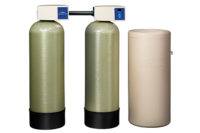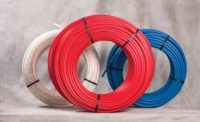
Figure 1.
You will get many definitions of “pure water” depending on the end user’s requirements and the application. It could be inorganic, organic, biological, even total organic carbon (TOC), total dissolved solids (TDS) and others. It could be a combination of one or more of the above parameters or even the end user’s own definition.
As an engineer or system designer, you must know what the end user’s definition of pure water is. Next you must know the quality of the incoming starting water, and you must have a detailed water analysis including the parameters in the end user’s definition of pure water. Additionally, you must know the flow rate of the pure water required; the volume required in some specific time, hour, day, week or month; and if there is a pressure requirement.
Depending on the definition of pure water, we can consider a couple of technologies at this point. The first and the simplest is demineralization or deionization, which is an ion exchange process. The second is membrane technology, which comprises microfiltration, ultrafiltration, nanofiltration and reverse osmosis. Other technologies, which I am not going to cover at this time, can be used in addition to and/or in place of the technologies discussed below, such as electrodialysis reversal (EDR) or electrodeionization (EDI).

Reverse osmosis is the tightest of the membranes. This Culligan G3 Series RO system can produce up to 288,000 GPD.
Deionization Defined
Deionization exchanges dissociated inorganic minerals in water with hydrogen and the hydroxyl ion. Therefore, it is really replacing minerals (inorganic) that are dissociated (dissolved) in water with water.There are several types of ion exchange resins: cation, strong base, weak base and mixed bed, which is a mixture of cation and strong base anion resins. They produce different qualities and quantities of water. Ion exchange does not generally remove organics unless they are highly polar.
Demineralization/deionization can constitute an automatic system regeneration with acid and caustic in the house or portable exchange service (PEDI). In PEDI, the end user contracts with a service provider who operates a regeneration facility and delivers exchange tanks of various sizes to the end user’s facility. The service provider replaces the exchange tanks when they are exhausted with regenerated tanks. This saves the end user from having to handle acid and caustic and having to make sure they are meeting the government effluent requirements. PEDI may be a better choice when the flow rate and volumes are reasonably small.

Culligan's Dual Bed Deionization unit can be purchased in various sizes to provide larger volumes and flow rates that may be required.
Membrane Technology
Membrane technology consists of a semi-permeable membrane whose openings are of various sizes. The openings allow different types of material to pass through the membrane while not allowing larger material or more polar material to pass through. The latter materials go to waste through a concentrate or waste stream to the sewer or other water uses within a plant.Microfiltration (MF) is the loosest pore size of the membranes and is used to remove total suspended solids (TSS) generally as a post-treatment for an ultrapure water system or other applications. The pore size is in the 0.1 to 3 micron range.
Ultrafiltration is a membrane system that does not remove ions. It does, however, reject organics in the molecular weight range of greater than 1,000 daltons such as larger organics, bacteria, colloids and pyrogens while allowing ions and smaller organics to pass through to the permeate (product water).
Nanofiltration (NF) is the next tightest membrane that will reject most polyvalent ions while allowing monovalent cations (sodium) and monovalent anions (chloride) to pass through the membrane. NF removes organics in a molecular weight range of 250-1,000 daltons. This membrane is often called a softening membrane.
Reverse osmosis (RO) is the tightest of the membranes that will reject up to 99 percent of the ions depending on the total dissolved solids (TDS) of the feed water and 99 percent of the viruses, bacteria, pyrogens and organics above a molecular weight of 200 daltons. Good pretreatment will improve the recovery (i.e. how much water goes to storage vs. how much goes to waste).
Most if not all membrane systems require pretreatment to improve the efficiency and life of the system. The pretreatment could consist of filtration for suspended solids and chlorine, water softening to reduce membrane fouling and/or the degradation of the membrane.
If the end user’s specification calls for the pure water to have a high resistivity or low conductivity, it may be necessary to polish the product water with mixed-bed PEDI exchange tanks to achieve the desired resistivity or conductivity. The water can be polished before or after the storage tank.

Portable Deionization Exchange (PEDI) tanks are used where less volume and flow rate are required and the user does not want to be concerned with effluent restrictions.
Water Storage
With a membrane technology system, the water can be stored in two ways. Small systems can use a bladder tank where low flow rates and lower pressures are acceptable. For larger systems, a large storage tank generally made of fiberglass, plastic (HDPE) or stainless steel (316L) will be necessary.If the end user is concerned about airborne bacteria, vent filters may be needed. There are generally two types of filters - a hydrophilic (water loving) and a hydrophobic (water hating). Hydrophobic will pass air but not water, while hydrophilic will pass air and water, but it will not pass air very well if it gets wet.
The vent filters must be sized large enough to handle the displacement of the air/water depending on draw down and fill rate. I have seen fiberglass tanks implode because the system had only a hydrophilic vent filter that had gotten wet. I always suggest both vent filters be installed and should be changed on a preventive maintenance basis depending on the environment in the area or at least once a year. If there are chemical vapors in the air, it may be necessary to use a carbon filter before the vent filters.
Ultraviolet Units
The specifications for the pure water may call for lower bacteria levels (CFU) or even total organic carbon levels (TOC). If so, it may be necessary to install one or more ultraviolet units in the system. The end user may want to lower the bacteria levels in the feed water to the membrane system to keep the membranes from biologically fouling or to keep the bacteria levels in the storage tank down to a specified level (CFU). If so, an ultraviolet unit with a 254NM (nanometer) bulb can be used. The bulb is designed for the quality of the feed water and flow rate. An ultraviolet 254NM unit can be installed on a recirculating loop back to the storage tank. If the TOC level is to be kept below a certain level (i.e., 500 ppb) an ultraviolet unit with TOC reducing bulbs (185NM) along with submicron filtration before and after the 185NM ultraviolet unit should be used. In my experience, this probably would be the last component before the point of use.It is important that the end user, specifying engineer and contractor use a supplier who is experienced in these types of systems - one who can offer sizing, commissioning, training and help in laying out the system.


